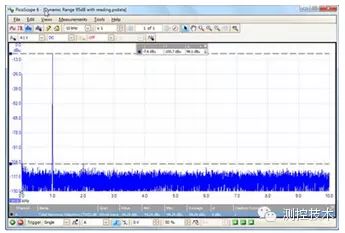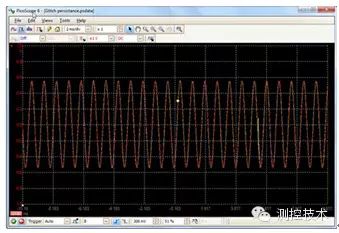
Basic Fault Diagnosis
PicoScope 4262 is a high-resolution oscilloscope, which is very suitable for general fault diagnosis. It has two input channels, allowing simultaneous display of signals in both time and frequency domains. The spectral view provides some automatic measurement data, including distortion and noise.
Dynamic Range
In most digital oscilloscopes, the analog-to-digital converter has only 8-bit resolution, which can produce 256 quantization levels. This corresponds to an ideal dynamic range of 48dB. The PicoScope 4262 has a 16-bit resolution analog-to-digital converter, capable of producing 65536 quantization levels, increasing the dynamic range to 96dB.
96dB is the theoretical best value, but in practice, there will be some noise in the acquisition system, which reduces the actual dynamic range.
The dynamic range of the signal generator and acquisition system is measured by directly connecting the output of the signal generator to the input of channel A, as shown in Figure 1.

Figure 1
Figure 1: Measuring dynamic range by outputting the signal from the signal generator to the oscilloscope
Figure 2 shows the spectrum in PicoScope. This is obtained by capturing a sine wave signal in the time domain and then clicking the frequency domain button.

Figure 2
To measure the dynamic range, we need to align the two scales of channel A (controlled by the blue box on the Y-axis) with the peak and noise level of the signal. By calculating the difference between the two scales, the dynamic range will be given in the scale box, approximately -98dB.
Detecting Waveform Distortion
This test detects the distortion of a stereo amplifier. It demonstrates how the PicoScope oscilloscope can automatically detect harmonics, even when the time-domain waveform appears very clean. The PicoScope 4262 has sufficient dynamic range to capture whether there is noise or distortion in these signals.

Figure 3: Distortion detection setup
Figures 4 and 5 show the PicoScope display divided into 4 views: time domain and frequency domain graphs for each channel. Each view can be added by right-clicking on the default view and selecting to add a view.

Figure 4
Figure 4: Four views of channels A and B, where channel B THD is -61dB. Distortion cannot be seen in the time domain view.

Figure 5
Figure 5: Increasing the output power level of channels A and B reveals distortion in the harmonic spectrum of some channels.
Glitch Detection
The PicoScope persistence mode is very useful for capturing unwanted points or audio signal faults. In the display of a regular oscilloscope, these signals only appear on the screen for a fraction of a second, making accurate measurement difficult. The persistence mode causes old waveforms to remain in the background while new waveforms continue to update on top.

Figure 6: Glitch detection setup
1. Click the persistence mode button in the PicoScope toolbar.
2. Remove the default settings or adjust by clicking the persistence mode.
The main options in the persistence mode are color persistence mode or analog precision mode.
Color persistence mode, as shown in Figure 7, makes the new waveform appear more vibrant in color compared to the old waveform, making faults easier to spot.
Analog precision mode has a similar effect but uses a different shading effect of one color. This looks more like the display effect of analog persistence.

Figure 7
Figure 7: Color persistence mode displays glitch signals in more vibrant colors.
Conclusion
The high resolution of the PicoScope 4262 makes it more suitable for detecting low noise, low distortion signals, and eliminates the need for additional signal sources with its built-in signal generator. The 5MHz bandwidth allows for quick analysis of audio, ultrasonic, and vibration signals as well as characteristic noise of switching mode power supplies, and measures distortion, performing precise measurement tasks.